Tackle technology moves on ever at a pace, but we anglers are often slow to follow and adapt our fishing to make the best use of these advances.
A prime example is that of bite detection. Rods are now lighter and slimmer in diameter giving better response, mono lines have improved, braid is getting thinner and stronger almost by the month, Fluorocarbon lines are gaining in popularity, yet these and a host of other small improvements we somehow choose to ignore. WSF aims to put some of these advancements alongside “old tricks” and bring bite detection forward in to the 21st century!
First things first, let’s kill the old chestnut that soft tips improve bite detection. At close range in calm clear seas when targeting smaller flatfish, whiting and eels, they can make a difference. Add a half decent surf, a strong wind, weed in the water and they become totally useless fluttering around all over the place.
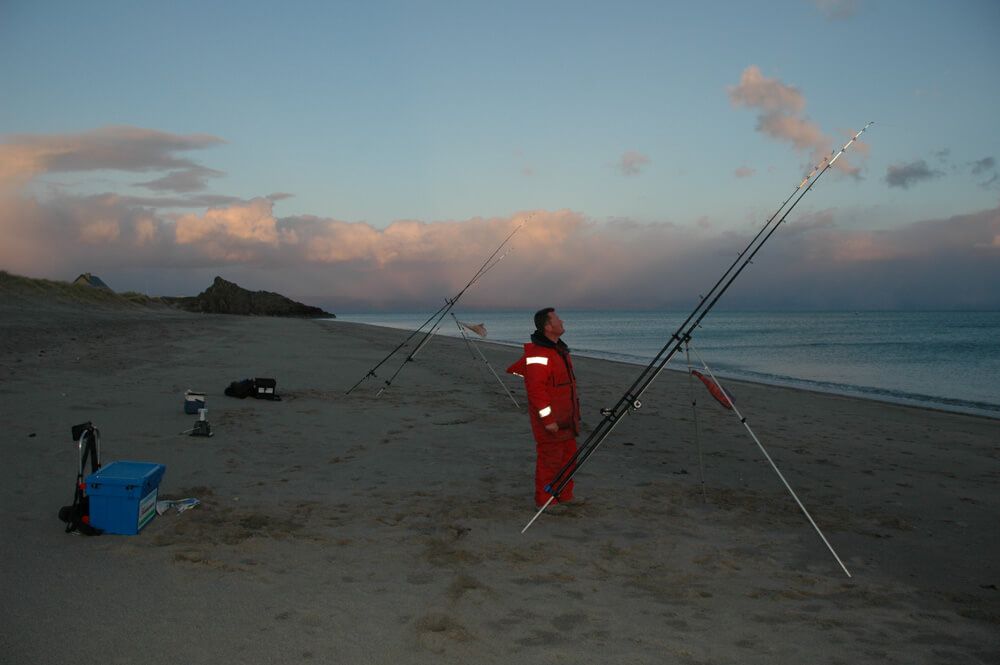
In normal fishing conditions you need to be choosing a rod with semi stiff tip balanced to a fast taper action. Soft all-through action rods that bend to the butt soak up far too much pressure and exaggerate movement at the rod tip responding to every little wave, and unless you’re experienced you’ll be striking at thin air.
Fast taper rods on the other hand have a semi supple tip but stiffer upper mid section that only responds to definite movement induced by real pull pressure. This is why powerful tournament style beachcasters respond with a proper rod tip rattle to small dabs ripping at a lug bait 150-yards out in the surf. Stiffer rods and stiffer tips give better overall bite detection!
This brings us on to long European style rods. Yes they give casters with limited technique improved casting distance, but if you fish these long rods in rougher conditions, their increased length and softer all through actions tend to limit bite detection at long range because the tips tend to wobble about in the wind more than conventional UK beachcasters would.
This is one reason why anglers proficient with long rods choose braided lines instead of mono for much of their long rod fishing. Combine a long rod with braided line and your bite detection is instantly improved 50% over mono due to the braid having no stretch compensating for the softer rod blank, but only in calmer conditions. In rougher seas, braid responds to every single tap of a passing surf table, tiny bit of weed and even undertow which to the inexperienced eye gives a false bite.
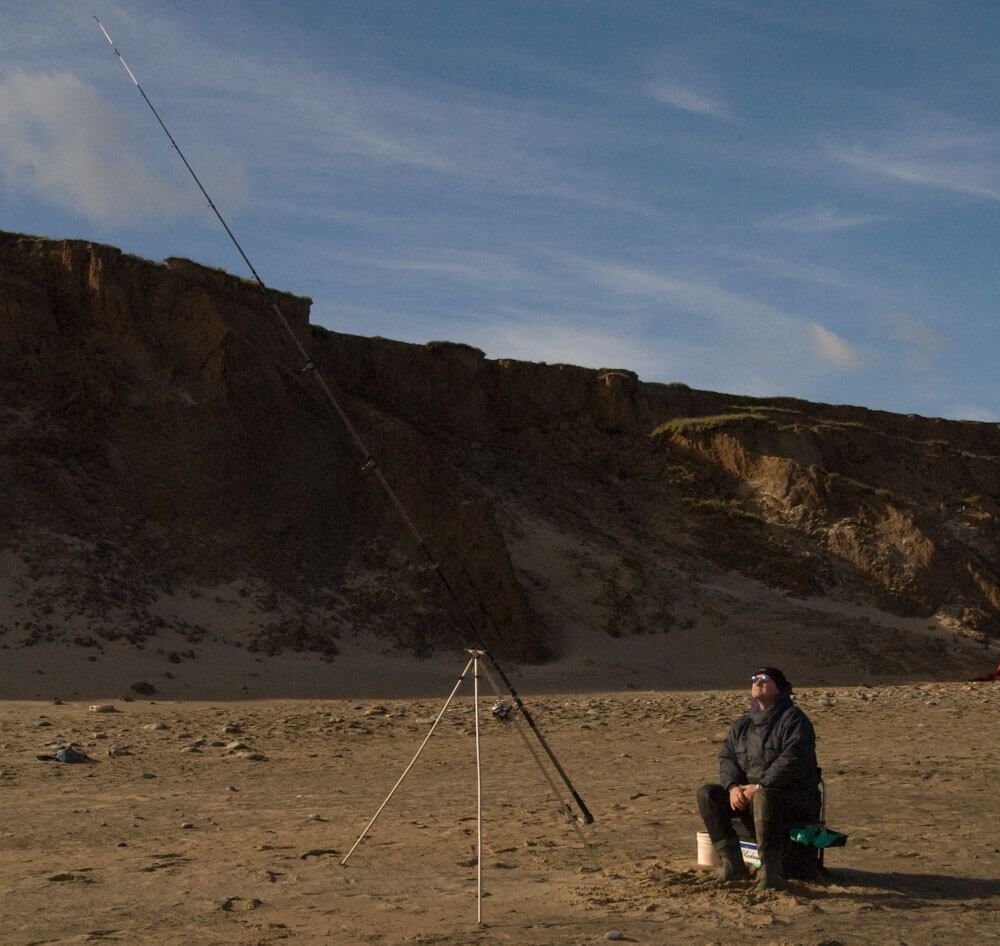
Walk a modern match or beach venue and look at the anglers. If the wind suddenly increases to strong those anglers fishing long rods will instantly drop the angle of the rod shallower in the rod rest to minimise wind effect on the rod tip. This low angle of line increases the chance of weed and wave sign on the rod tip destroying bite detection. Those using conventional fast taper beach casters can retain a high rod angle and simply tighten the line a little more to pull the rod tip over in to a more obvious curve against the lead to better highlight bites.
It’s also important to choose your main reel line wisely. Some mono lines stretch much more than others. There are too many brands out there to individually separate but lines such as Sufix Tritanium and especially Berkley Trilene Sensation seem to tense up and stiffen on the strike which puts greater rod pressure through to the hook point for maximum hook point pressure giving improved bite detection and hook ups
A fair line test is to get a 4-foot section and pull it between the hands. Stretchy lines you’ll feel do just that, stretch, but high tension lines give a little then lock. Yes the more line you have out the less bite detection you will have, but it’s all about improvement bit by bit, and high tension lines pull the percentages back in your favour when casting to long range.
Pending developments in Fluoro carbon main lines, which already minimise stretch compared to mono main lines, suggest Fluorocarbon could start to overtake mono for long range bite detection and even approach braid for more direct contact in the future. Something to watch out for!
The way you set up your rod rest is also important. In still calm weather, or in a strong overhead wind, it pays to have your rods set up parallel to the beach with the rod tips as low as you can. This means setting up the rod rest with a long back leg and the two front legs short to get the rod tips low. This is where standard rod rests with a fixed length back leg lose out. This low, parallel rod tip angle means that the line is pulling at right angles to the rod tip and highlights the slightest pull.
When fishing onshore wind conditions then the rod tips are best high up in the rod rest and pointing at the sea with the line tight between the rod tip and lead. This highlights even small bites at long range.
In really rough weather extend your rod rest as high as you can and elevate the rods tips as high as possible. True fast taper, stiff tipped rods will combat wind movement, but their tip height also means that the line bow is up above the inshore waves which dramatically improves bite detection and minimises chance contact with inshore weed.
In the case of a very strong side wind there are two things you can do to maximise bite detection. Firstly is to walk into the wind up the beach between 30 and 40-yards, then cast, then as you walk back retrieve line on to the reel. When you get back to the rod rest the line will be straight out from the rod tip and will not bow away with the wind. A straight tight line gives vastly superior bite detection than a bowed line can.
This same principle can be used to maintain good bite detection and maintain the leads grip in the seabed when fishing in to strong sideways tidal currents. Walking in the direction of the oncoming tide and casting, walking back and retrieving line, again takes the bow out of the line and keeps it straight to maximise direct movement on the rod tip.
Also when fishing strong side winds and side currents, again position the rod rest to allow the rods to fish parallel with the beach facing downwind, and have the rod rests at about 50-degrees angle in the rest. This sideways angle of the rod tips and shallowed angle works best with any slight bow in the line and is more efficient at showing bites than having the rods facing the sea directly.
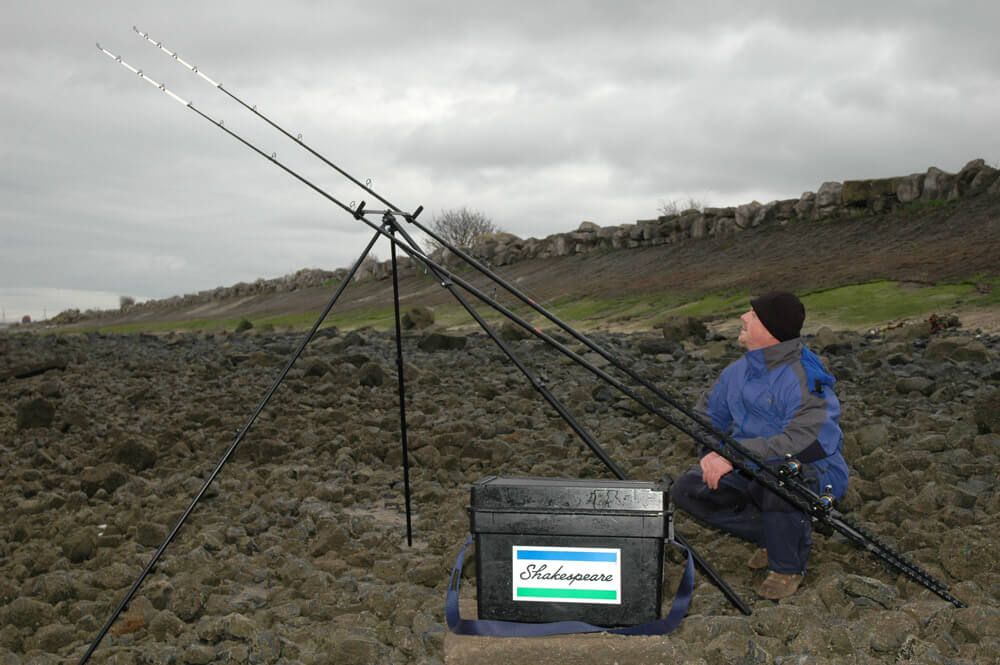
A simple way to improve visible bite detection at night is to add reflector tape to your rod tips. We’ve been doing this for the best part of 20-years now and it is highly effective being used to reflect light to identify the backs of trailers and caravans at night. It is so good that you can walk away from your rod tip 40-yards, put your headlight beam on your rod tips and they’ll stand out brightly against the darkness. They also catch the smallest amount of indirect light, so you often see bites out of the corner of your eye when baiting up etc.
When applying the tape, which you can get from good motor factor shops, extend it down between the top intermediate rings a good 14-inches on a 12-foot plus rod, and 18-inches on 13-foot plus rods. This long length helps you clearly see the smaller rattles at night.
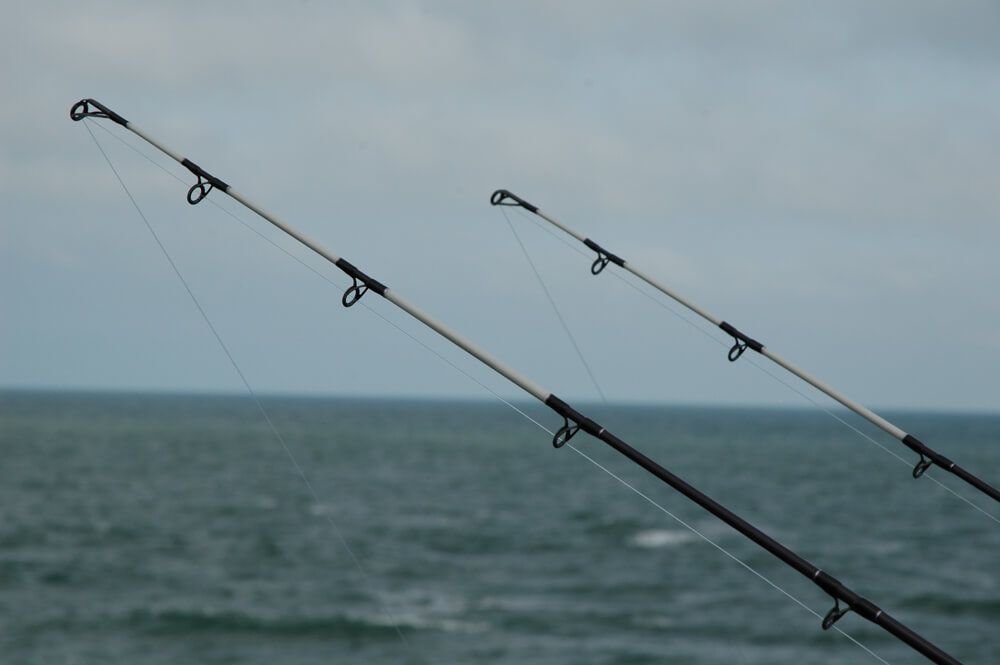
It’s no status symbol that experienced anglers choose to fish two identical rods side by side. Having two identical rod tips close together means that they will react to surf and wind conditions identically at any given time. If one moves slightly out of character to the other it means that there is a high probability that it’s a bite. If you can, always fish two rods side by side, and better still if they are the same identical rod blank, you’ll catch more fish overall.
The ultimate is achieved when bass fishing when stood in the surf holding the rod and combining some of the things we’ve highlighted above such as the correct fast taper rod blank and line type. However bass rods require even more attention to detail.
What really kills the information travelling up the line and in to the blank is EVA and Hyperlon foam grips. These nullify and soak up much of the direct feel in the rod and slow down reaction time. Look at any top bass angler and his rods will be built “bare bones” style. That means no foam fore grip and no reel seat. Typically true bass rods for holding all the time when feeling for bites have only shrink tube on the butt section and basic coasters or a lightweight Penn Talon for reel security. Fine, if you don’t like coasters use a reel seat, but you’re adding weight and loosing information coming directly in to your hands. It’s your call!
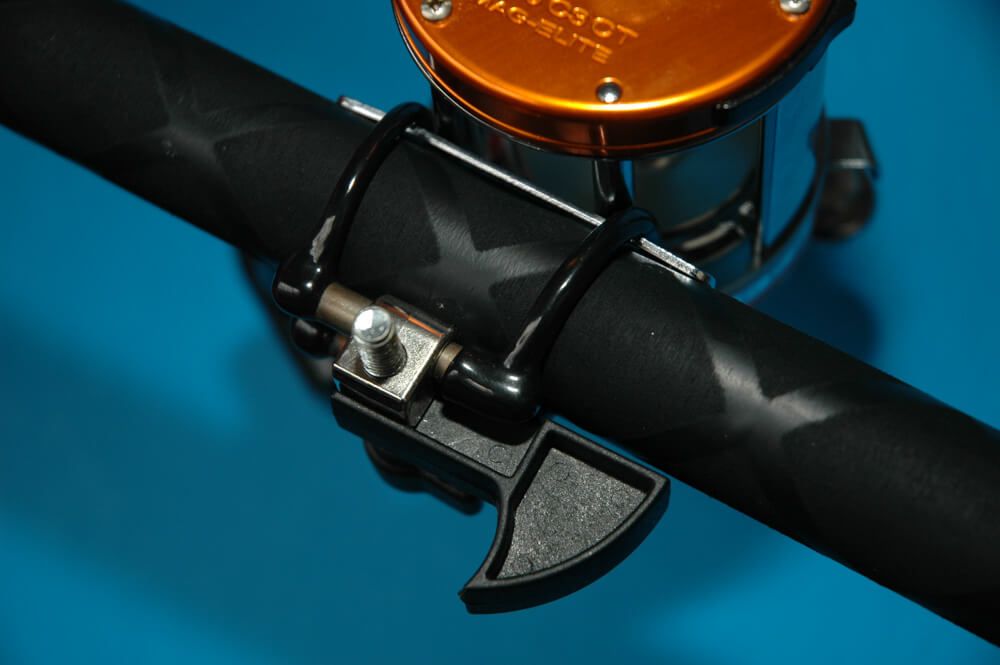
Having your hands on the hard feel of the butt means everything that transmits upwards through the line and down through the blank is instantly interpreted from your hands to your brain. This results in developing a true feel for what’s happening at the bait end and results in a much faster strike response. Not all bass bites are “wallop, bang”, many are subtle gentle “twitches” and nothing else. Many anglers guess these as crabs picking at the bait, but loose the foam grips on your rod and these become definite hittable bites. The direct feel of a bare bones bass rod compared to a rod built with foam grips is chalk and cheese!
There you have it, a modern look at bite detection! Some things will surprise you, and without trying them you might disagree with some of them, but these simple changes can dramatically increase your overall catch rate. The future’s bright if you’re fishing tight!
A prime example is that of bite detection. Rods are now lighter and slimmer in diameter giving better response, mono lines have improved, braid is getting thinner and stronger almost by the month, Fluorocarbon lines are gaining in popularity, yet these and a host of other small improvements we somehow choose to ignore. WSF aims to put some of these advancements alongside “old tricks” and bring bite detection forward in to the 21st century!
First things first, let’s kill the old chestnut that soft tips improve bite detection. At close range in calm clear seas when targeting smaller flatfish, whiting and eels, they can make a difference. Add a half decent surf, a strong wind, weed in the water and they become totally useless fluttering around all over the place.

In normal fishing conditions you need to be choosing a rod with semi stiff tip balanced to a fast taper action. Soft all-through action rods that bend to the butt soak up far too much pressure and exaggerate movement at the rod tip responding to every little wave, and unless you’re experienced you’ll be striking at thin air.
Fast taper rods on the other hand have a semi supple tip but stiffer upper mid section that only responds to definite movement induced by real pull pressure. This is why powerful tournament style beachcasters respond with a proper rod tip rattle to small dabs ripping at a lug bait 150-yards out in the surf. Stiffer rods and stiffer tips give better overall bite detection!
This brings us on to long European style rods. Yes they give casters with limited technique improved casting distance, but if you fish these long rods in rougher conditions, their increased length and softer all through actions tend to limit bite detection at long range because the tips tend to wobble about in the wind more than conventional UK beachcasters would.
This is one reason why anglers proficient with long rods choose braided lines instead of mono for much of their long rod fishing. Combine a long rod with braided line and your bite detection is instantly improved 50% over mono due to the braid having no stretch compensating for the softer rod blank, but only in calmer conditions. In rougher seas, braid responds to every single tap of a passing surf table, tiny bit of weed and even undertow which to the inexperienced eye gives a false bite.

Walk a modern match or beach venue and look at the anglers. If the wind suddenly increases to strong those anglers fishing long rods will instantly drop the angle of the rod shallower in the rod rest to minimise wind effect on the rod tip. This low angle of line increases the chance of weed and wave sign on the rod tip destroying bite detection. Those using conventional fast taper beach casters can retain a high rod angle and simply tighten the line a little more to pull the rod tip over in to a more obvious curve against the lead to better highlight bites.
It’s also important to choose your main reel line wisely. Some mono lines stretch much more than others. There are too many brands out there to individually separate but lines such as Sufix Tritanium and especially Berkley Trilene Sensation seem to tense up and stiffen on the strike which puts greater rod pressure through to the hook point for maximum hook point pressure giving improved bite detection and hook ups
A fair line test is to get a 4-foot section and pull it between the hands. Stretchy lines you’ll feel do just that, stretch, but high tension lines give a little then lock. Yes the more line you have out the less bite detection you will have, but it’s all about improvement bit by bit, and high tension lines pull the percentages back in your favour when casting to long range.
Pending developments in Fluoro carbon main lines, which already minimise stretch compared to mono main lines, suggest Fluorocarbon could start to overtake mono for long range bite detection and even approach braid for more direct contact in the future. Something to watch out for!
The way you set up your rod rest is also important. In still calm weather, or in a strong overhead wind, it pays to have your rods set up parallel to the beach with the rod tips as low as you can. This means setting up the rod rest with a long back leg and the two front legs short to get the rod tips low. This is where standard rod rests with a fixed length back leg lose out. This low, parallel rod tip angle means that the line is pulling at right angles to the rod tip and highlights the slightest pull.
When fishing onshore wind conditions then the rod tips are best high up in the rod rest and pointing at the sea with the line tight between the rod tip and lead. This highlights even small bites at long range.
In really rough weather extend your rod rest as high as you can and elevate the rods tips as high as possible. True fast taper, stiff tipped rods will combat wind movement, but their tip height also means that the line bow is up above the inshore waves which dramatically improves bite detection and minimises chance contact with inshore weed.
In the case of a very strong side wind there are two things you can do to maximise bite detection. Firstly is to walk into the wind up the beach between 30 and 40-yards, then cast, then as you walk back retrieve line on to the reel. When you get back to the rod rest the line will be straight out from the rod tip and will not bow away with the wind. A straight tight line gives vastly superior bite detection than a bowed line can.
This same principle can be used to maintain good bite detection and maintain the leads grip in the seabed when fishing in to strong sideways tidal currents. Walking in the direction of the oncoming tide and casting, walking back and retrieving line, again takes the bow out of the line and keeps it straight to maximise direct movement on the rod tip.
Also when fishing strong side winds and side currents, again position the rod rest to allow the rods to fish parallel with the beach facing downwind, and have the rod rests at about 50-degrees angle in the rest. This sideways angle of the rod tips and shallowed angle works best with any slight bow in the line and is more efficient at showing bites than having the rods facing the sea directly.

A simple way to improve visible bite detection at night is to add reflector tape to your rod tips. We’ve been doing this for the best part of 20-years now and it is highly effective being used to reflect light to identify the backs of trailers and caravans at night. It is so good that you can walk away from your rod tip 40-yards, put your headlight beam on your rod tips and they’ll stand out brightly against the darkness. They also catch the smallest amount of indirect light, so you often see bites out of the corner of your eye when baiting up etc.
When applying the tape, which you can get from good motor factor shops, extend it down between the top intermediate rings a good 14-inches on a 12-foot plus rod, and 18-inches on 13-foot plus rods. This long length helps you clearly see the smaller rattles at night.

It’s no status symbol that experienced anglers choose to fish two identical rods side by side. Having two identical rod tips close together means that they will react to surf and wind conditions identically at any given time. If one moves slightly out of character to the other it means that there is a high probability that it’s a bite. If you can, always fish two rods side by side, and better still if they are the same identical rod blank, you’ll catch more fish overall.
The ultimate is achieved when bass fishing when stood in the surf holding the rod and combining some of the things we’ve highlighted above such as the correct fast taper rod blank and line type. However bass rods require even more attention to detail.
What really kills the information travelling up the line and in to the blank is EVA and Hyperlon foam grips. These nullify and soak up much of the direct feel in the rod and slow down reaction time. Look at any top bass angler and his rods will be built “bare bones” style. That means no foam fore grip and no reel seat. Typically true bass rods for holding all the time when feeling for bites have only shrink tube on the butt section and basic coasters or a lightweight Penn Talon for reel security. Fine, if you don’t like coasters use a reel seat, but you’re adding weight and loosing information coming directly in to your hands. It’s your call!

Having your hands on the hard feel of the butt means everything that transmits upwards through the line and down through the blank is instantly interpreted from your hands to your brain. This results in developing a true feel for what’s happening at the bait end and results in a much faster strike response. Not all bass bites are “wallop, bang”, many are subtle gentle “twitches” and nothing else. Many anglers guess these as crabs picking at the bait, but loose the foam grips on your rod and these become definite hittable bites. The direct feel of a bare bones bass rod compared to a rod built with foam grips is chalk and cheese!
There you have it, a modern look at bite detection! Some things will surprise you, and without trying them you might disagree with some of them, but these simple changes can dramatically increase your overall catch rate. The future’s bright if you’re fishing tight!

